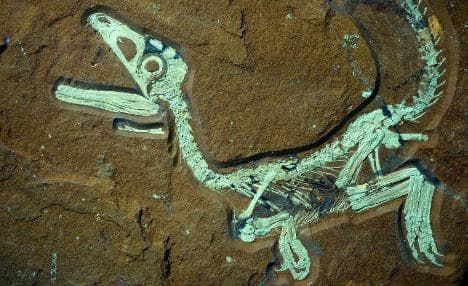T-Rex babies were 'fluffy'

The mighty Tyrannosaurus Rex may have been the king of the dinosaurs – but its skin was downy, rather than scaly, and the babies were positively fluffy with feathers, latest fossil examinations show.
Oliver Rauhut, conservator at the Bavarian Collection for Palaeontology and Geology said evidence had been found during detailed examination of what has been described as the most complete fossilised dinosaur ever found.
The 70-centimetre long baby predator dinosaur, a 150 million-year-old relative of the Tyrannosaurus Rex, was first shown to the public last October, and was given the scientific name Sciurumimus albersdoerferi.
“Under ultraviolet light, one can see the remains of skin and the plumage as luminous spots and fibres on the skeleton,” said Helmut Tischlinger, one of the authors of a paper published in this month’s Proceedings of the Academy of Sciences of the US journal (PNAS).
It even had a bushy tail, which gave rise to the name Sciurus – from squirrel.
It seems the specimen was freshly hatched. “We now know with certainty that as young animals they had feathers, but we also cannot rule out that a fully grown Tyrannosaurus Rex was still fluffy,” said Rauhut.
Feathered dinosaurs caused a sensation when they were found in China last year – particularly as the feathers were not for flying but for insulation.
“That is probably solely to serve as insulation. And such a body covering would only make sense if the dinosaur had certain abilities to regulate their body temperatures,” said Rauhut. This means they were warm-blooded - at least to some degree.
“In certain ways, one can say that they were more highly evolved,” he said.
Baby dinosaur fossils are rare as they were often eaten, while the bones of those who died young were small and fragile and less likely to be fossilised, said Rauhut.
But this one, which is 98 percent intact, showed sharp narrow teeth at the end of its snout which would suggest it largely ate insects and small animals.
Once adult though, the Sciurumimus albersdoerferi would have been at least six metres tall, weighing about a tonne, hunting other dinosaurs.
“For a long time, we thought that the way of life of dinosaurs changed as they grew,” said Rauhut.
He added that even though it seemed as if they were fluffy, they were still “the most dangerous predators, at the top of the ecological pyramid.”
DPA/The Local/hc
Comments
See Also
Oliver Rauhut, conservator at the Bavarian Collection for Palaeontology and Geology said evidence had been found during detailed examination of what has been described as the most complete fossilised dinosaur ever found.
The 70-centimetre long baby predator dinosaur, a 150 million-year-old relative of the Tyrannosaurus Rex, was first shown to the public last October, and was given the scientific name Sciurumimus albersdoerferi.
“Under ultraviolet light, one can see the remains of skin and the plumage as luminous spots and fibres on the skeleton,” said Helmut Tischlinger, one of the authors of a paper published in this month’s Proceedings of the Academy of Sciences of the US journal (PNAS).
It even had a bushy tail, which gave rise to the name Sciurus – from squirrel.
It seems the specimen was freshly hatched. “We now know with certainty that as young animals they had feathers, but we also cannot rule out that a fully grown Tyrannosaurus Rex was still fluffy,” said Rauhut.
Feathered dinosaurs caused a sensation when they were found in China last year – particularly as the feathers were not for flying but for insulation.
“That is probably solely to serve as insulation. And such a body covering would only make sense if the dinosaur had certain abilities to regulate their body temperatures,” said Rauhut. This means they were warm-blooded - at least to some degree.
“In certain ways, one can say that they were more highly evolved,” he said.
Baby dinosaur fossils are rare as they were often eaten, while the bones of those who died young were small and fragile and less likely to be fossilised, said Rauhut.
But this one, which is 98 percent intact, showed sharp narrow teeth at the end of its snout which would suggest it largely ate insects and small animals.
Once adult though, the Sciurumimus albersdoerferi would have been at least six metres tall, weighing about a tonne, hunting other dinosaurs.
“For a long time, we thought that the way of life of dinosaurs changed as they grew,” said Rauhut.
He added that even though it seemed as if they were fluffy, they were still “the most dangerous predators, at the top of the ecological pyramid.”
DPA/The Local/hc
Join the conversation in our comments section below. Share your own views and experience and if you have a question or suggestion for our journalists then email us at [email protected].
Please keep comments civil, constructive and on topic – and make sure to read our terms of use before getting involved.
Please log in here to leave a comment.